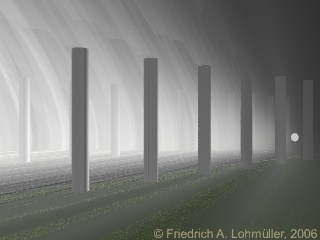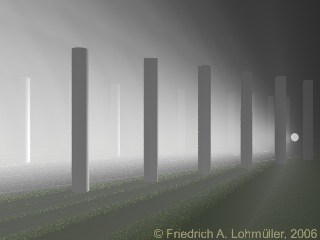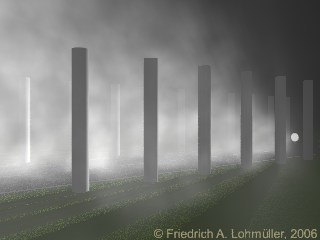Home
- POV-Ray Tutorial
Content Overview
material, interior, media
- Syntax material
texture + interior
- Window Glass
+ max_trace_level
- Fog, Mist or Haze
Media
- Syntax Media
- Media+Density Maps
Atmospheric Media
with/without density map
- Beames in the Fog
Object Media
Emitting Media
- Light Sword
- Candle Flames
Scattering Media
- Light through Window
- Steam, Smoke, Clouds
Absorbing Media
- Dust Devils
Special Problems with Media
- Scaling of Media
- Overlapping Media
|
Beames in the Fog
with Atmospheric Media
Using "media" keyword
for atmospheric effects
outside of objects
|
lights in low beam and high beam with fog
|
|
|
|
To simulate fog interacting with lights POV-Ray uses
so called volume sampling (calculating and adding together the effect on a limited number of layers of planes beteen the
camera and the objects), this works only for a finite ray which hits an object.
Note: POV-Ray cannot sample media along an infinitely long ray.
The ray must be finite in order to be possible to sample.
This means that sampling media is only possible for rays that hit an object in a finite distance!
So no atmospheric media will show up against "background" or "sky_sphere",
beause these objects by definition are in an infinite distance.
Using spotlights with media in general is no problem, because also in this case the ray is not infinite
(it is sampled only inside the spotlight cone).
It's possible to make lights not interacting with the atmosphere media
by adding the keyword "media_interaction off" to the light source statement.
So we can increase the overall light level of a scene for more realism.
For media effects restricted on particular areas,
it's better (faster and more accurate) to use "object media" than media patterns.
|
Spotlight without media fog.
|
Fog with scattering media:
(scattering = light spreading distributing in all directions)
To produce a global light scattering atmospheric media
for fog, we can use "media" without any limitating container:
media{
scattering{
1, // scattering media type 1,2,3,4,5
0.1 // color of the media (no comma!)
extinction 0.25//optional 0~1
// = how fast the media absorbs light
}//----------------------------------------
|
This looks pretty rough!
|
|
Once again, but more precisely:
media{
scattering{
1, // scattering media type 1,2,3,4,5
0.1 // color of the media (no comma!)
extinction 0.25//optional 0~1
}// end of scattering
intervals 20 // default 10 //
// = how many samples are tooken into
// consideration.
// The intervals span the entire length
// of the ray from camera to where it
// hits an object
}//----------------------------------------
|
|
|
More irregular, more cloudy with density map:
media{
scattering{
1, // scattering media type 1,2,3,4,5
0.3 // color of the media (no comma!)
extinction 0.25 //optional 0~1
}// end of scattering
intervals 20 //
density {granite scale 10
color_map {
[0.0 rgb <1,1,1>*0.1]
[0.5 rgb <1,1,1>*0.3]
[1.0 rgb <1,1,1>*1 ]
} // end of color_map
}// end of density
}//----------------------------------------
|
|
|
|




